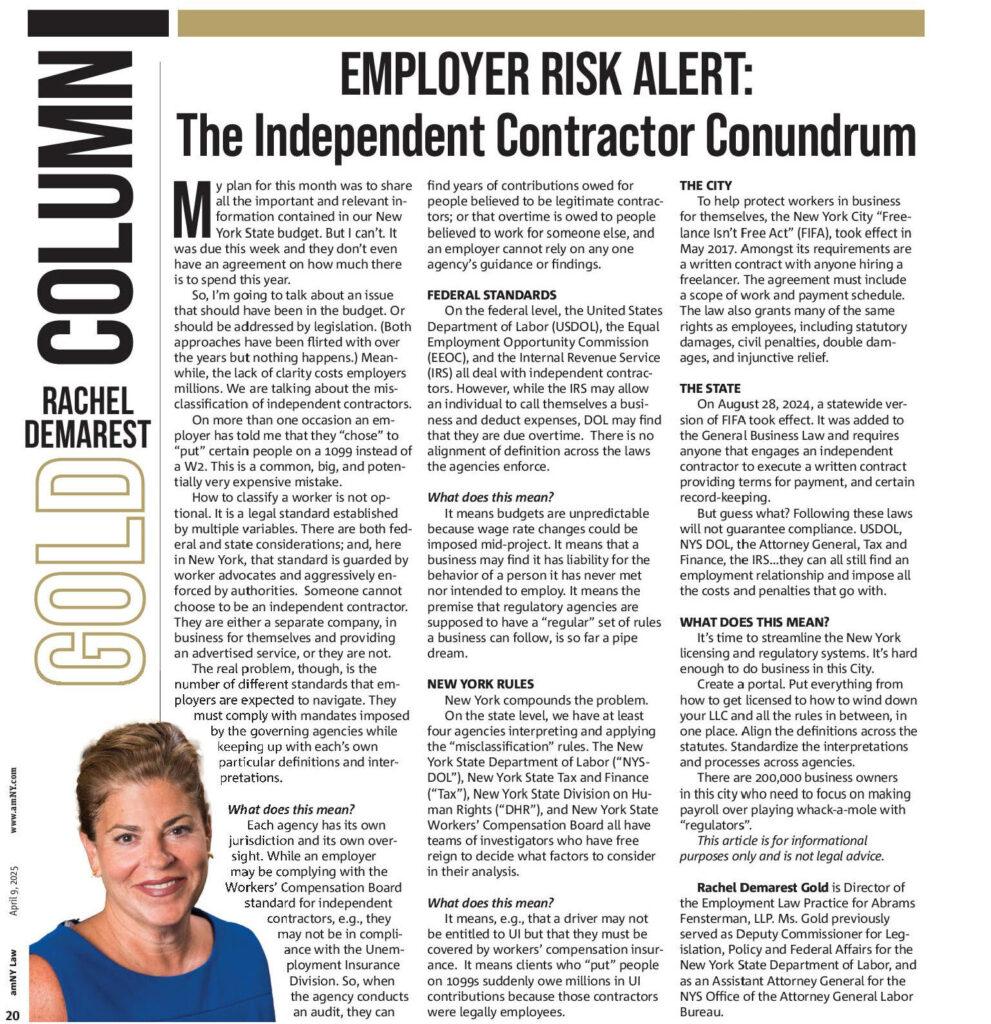By: David Verschell & Jordan Fensterman
Article appeared in the summer issue of MM “NEWS”, a publication of the New York County Medical Society
PART I – Introduction and Medical Malpractice
Introduction
The legal aspects of the practice of medicine continue to grow in complexity. Increasing rules and regulations placed upon health care professionals by state and federal governments place physicians at increased risk of regulatory scrutiny, professional discipline and potential civil liability. Physicians have also come to realize that the actions of their staff play a central role in minimizing risk and potential liability exposure.
This two-part series provides a general framework for physicians to understand how staff interaction with patients can have a serious impact upon areas of risk and liability in three primary areas. These articles will cover issues that confront health care providers every day, including: Medical Malpractice Actions, Professional Licensure Investigations and Insurance Carrier Audits.
Physicians and their staff need to be cognizant of risk management principles during the operation of their offices that can impact these and other areas. These articles will provide general suggestions for providers working with their staff to manage the risk that they – and their practice – face every day.
Medical Malpractice
Many medical malpractice claims share common allegations and themes that can be avoided if physicians and their office staff have the proper risk management training and put defensive measures in place. There are several simple, yet important, steps that every office can take to reduce the risk of litigation and to manage a claim once it arises.
It is important to remember that a malpractice lawsuit can be initiated by any person interacting with a physician! What is crucial is addressing a possible claim up front, from the point of patient dissatisfaction through commencement of an action, and knowing what can be done to prevent future litigation.
Adverse medical outcomes are the most common cause for complaints that may lead to an allegation that a physician committed medical malpractice. It is important to realize, however, that many claims of malpractice are asserted despite clear evidence that the physician acted at all times in accordance with good and accepted medical practice. The most effective way for physicians to minimize the exposure attendant with a poor medical outcome is ensure that all pertinent positive and negative information is contained in the patient’s chart.
Physicians are reminded that the maxim “if it isn’t documented it didn’t occur” holds great sway with a jury of their peers. The ability to point to an entry in the medical chart documenting that patients have either been non-compliant with medical recommendations, have factors that will increase the risk of the procedure, and have been explained the risks of the procedure goes far in convincing a jury that the physician acted within the standards of good and accepted medical practice, as well as provided proper informed consent.
That having been said, it is critical that the physician and his or her staff have proper record keeping and storage systems and protocols in place to preserve medical records. Missing clinical records (or any portion thereof) can have a serious and detrimental impact on a provider’s ability to defend against a claim of malpractice or general negligence. Case law shows that if a provider cannot produce all pertinent medical documentation, his or her testimony regarding the care and treatment of the patient will be often be suspect in the eyes of the jury. Moreover, the detrimental effect of missing medical records is compounded by a jury charge that a court may give to the jury permitting the jurors to make negative inferences from the fact that pertinent medical records are missing or unavailable. Documentation and proper record keeping are keys to avoiding and defending malpractice litigation. Clear and concise records, using standard abbreviations and noting pertinent positives and negatives are to the benefit of both the patient and the doctor. Regulations in New York State mandate that physicians and other health care providers maintain medical records for a specific period of time. Failure to maintain these records for the statutory period may result in civil liability, as well as have professional licensure implications.
Providers should further be mindful that many unjustified lawsuits are filed as a result of misunderstandings and poor communication between the office staff and the patient. Failure to follow up and non-responsiveness can leave patients feeling less than well cared for, while those patients who have their pertinent questions answered in a timely and friendly manner are more likely to place trust in the physician and accept the physician’s explanation for adverse outcomes. Too often, however, medical office staffs are left without clear direction on how to conduct themselves when they receive patient complaints. Staff should receive instruction on what type of complaints and concerns they may receive from patients, and a clear protocol should be established in each office for reporting patient complaints and concerns in a timely manner to the physician to trigger prompt action.
Depending on the practice’s resources, periodic meetings to explain expected complications from new procedures or the expected symptoms of seasonal maladies would be appropriate. However, while patient care should be considered a “team effort”, non-medical staff should be clearly instructed that they are not to provide medical advice or recommendations that may expose the physician to liability on an “agency” theory. It should be periodically reinforced to non-medical staff that they are responsible for assisting in the administrative operation of the office and to be the conduit between the patient and the physician. All medical comments and recommendations need to come from qualified health care providers.
As professionals in the medical industry, physicians should always strive to achieve better outcomes and run efficient practices. Risk management is an undeniably crucial part of achieving such success. Ultimately, a few small changes can have a lasting and beneficial effect on your medical practice and the health and happiness of your patients. Part two of this series will cover some of the risk management protocols and considerations that should be reviewed by physicians and their office staff, specifically regarding the Office of Professional Medical Conduct, physician discipline and insurance carrier audits. Stay tuned.





